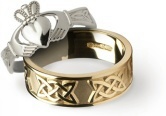History of Celtic & Irish Jewelry
Celtic language and culture first reached Ireland at around 500 B.C. The culture and style of artwork that immediately followed is called La Tène, after an area of Switzerland where artifacts reflecting La Tène style were first found. La Tène artwork is defined by curves and spirals; representative art, such as human figures, is rarely seen. Rather, the symbols are geometric or abstract, such as the common triple spiral design.
Owing to its lasting power, many metal Celtic jewelry pieces have been discovered from this time period. One common item found are torcs, which were likely a status symbol. Since jewelry is both decorative and made of precious metals, most jewelry discovered in archaeological sites is determined to be decorative rather than practical. Around the same time that Celtic culture found its way into Ireland, the Irish Iron Age took hold, combining the new Celtic culture with the old Irish culture. While iron was used for tools, jewelry and other pieces were made from the more impressive and long-lasting bronze and gold. One example of a masterful piece of Celtic jewelry from Ireland is the Broighter Collar.
The Broighter Collar is a torc that was found with the Broighter Hoard, which also included other pieces of jewelry. The Collar is made of gold and decorated with a curved, geometric pattern as is typical of Celtic art at the time. Torcs or collars are associated with prestige in Celtic culture; kings and gods would wear them. The Collar and the rest of the hoard are among the finest examples of La Tène goldwork and Celtic jewelry.
Around 600 A.D., Christianity began to surface in Ireland. Religious beliefs mixed with Celtic and Irish art, producing a new style known as Insular art. Insular Art is famous for its illuminated manuscripts, the Book of Kells being the most notable example. Insular art maintained the geometric, interlaced style that was present in La Tène art.
Many brooches were made during this time period. The Tara Brooch is particularly impressive, made of silver-gilt and decorated with filigree and interlace design. This style is repeated throughout Celtic jewelry. Irish metalworkers also created the Ardagh Chalice around this time, and it remains one of the most impressive Celtic creations, made of 354 separate pieces put together to make a chalice intricately decorated with the interlace typical of Celtic Irish art. While jewelry remained a status symbol, it was often infused with Christian elements, such as the apostles' names on the Ardagh Chalice, giving special prestige and meaning to some pieces.
The Christian influence also resulted in crosses, which were very common around the ninth century. The Cross of Cong is an example of the excellent goldsmithing skills of Celtic artists. The Cross of Cong had high religious value when it was created, as it was initially made to hold a piece of the cross the Irish believed Christ was crucified on.
Celtic influence is still very strong in Irish jewelry today. The iconic Celtic Cross is a common theme, though historians and researchers can only speculate upon the meaning of the ring at the intersection. Celtic knots are also a familiar symbol, used today to honor Irish and Celtic jewelry tradition. Through modern Celtic jewelry, the masterful metalworkers of the past live on.
- History of Celtic & Irish Jewelry
- Hallmarked in Ireland
- Jewelry Care
- Celtic Wedding Bands
- Claddagh Jewelry
- Celtic Bracelets
- Celtic Brooches
- Celtic Coat of Arms
- Celtic Cross Jewelry
- Celtic Cross Necklaces
- Celtic Cross Pendants
- Celtic Earrings
- Celtic Engagement Rings
- Celtic Gift Jewelry
- Celtic Knot Jewelry
- Celtic Knot Rings
- Celtic Pewter Earrings
- Celtic Pewter Jewelry
- Celtic Pewter Necklaces
- Celtic Pewter Pendants
- Celtic Tie-Pins
- Celtic Platinum Wedding Bands
- Celtic Platinum Wedding Rings
- Celtic Silver Rings
- Celtic Watches
- Celtic Wedding Jewelry
- Celtic Wedding Ring Sets
- Celtic Wedding Rings
- Celtic White Gold Wedding Bands
- Celtic White Gold Wedding Rings
- Claddagh Engagement Rings
- Claddagh Wedding Bands
- Claddagh Wedding Rings
- Gold Claddagh Rings
- History Of Ireland Jewelry
- History Of Ireland Symbols Explained
- Irish Bracelets
- Irish Celtic Gifts
- Irish Celtic Jewelry
- Irish Claddagh Rings
- Irish Coat Of Arms
- Irish Earrings
- Irish Linen Tablecloths
- Irish Necklaces
- Irish Surname Coat of Arms
- Irish Surname Meanings
- Irish Wedding Bands
- Irish Wedding Rings
- Mens Celtic Wedding Rings
- Mens Claddagh Rings
- Pewter Celtic Cross
- Silver Celtic Jewelry
- Silver Claddagh Rings
- Impressions of Ireland Symbols Explained
